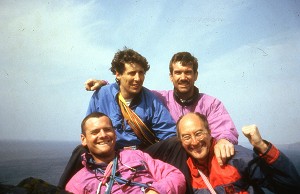
Donegal, in the northwest of Ireland, contains more climbable rock than the rest of Ireland combined, with two major mountain ranges, eight hundred miles of coastline, one hundred sea stacks and as many climbing mediums as you'll find in the rest of the country combined. There are currently just under 3,000 routes recorded throughout the county.
These climbs include Ireland's longest rock climb, largest mountain crag, longest ice climb and highest sea stack as well as many more standard single and multi-pitch venues above the sea, by the road, on the islands and in the mountains. County Donegal currently plays host to a lifetime of excellent rock climbing in some of the most beautiful, remote and unspoilt locations in Ireland.
History
The seemingly ubiquitous W.P. Haskett Smith ascended a coastal ridge in around 1890, but little then happened until a decade after WW2. Climbers like Frank Winder, Betty Healy, Harold Drasdo and Andrew Maxfield started creating classic mountain routes. In the late sixties the next generation led by Emmet Goulding, Patrick O'Leary, Paul McDermott and later by Lindsay Griffin, Se Billane and Calvin Torrans put up many routes on larger cliffs.
Doug Scott's ascent of Main Mast on Sail Rock in 1967 marked the beginning of the movement away from the granite highlands and the development of the immense potential of the coastline. 1974 saw the development begin in earnest with Leonard, McKenzie, Tom Ryan, Calvin Torrans and Eddie Cooper all being involved.
By the mid eighties the team of Al Millar, Paul and Raymond Dunlop and Niall Grimes began putting up the harder routes around the peninsula culminating in the classic E4 Atlantic Ocean Wall at Kinnego Bay.
In the summer of 1990 Muckross Head became Donegal's premier hard crag. It soon had forty steep, hard routes in a hundred metre stretch of uniquely bedded overhanging cliff. Most of the hard climbers on the Irish scene at the time left their mark including Robbie Fenlon, Donnie O'Sullivan, Eddie Cooper, Howard Hebblethwaite and Brian Callan.
Owey & Gola Islands were discovered in the mid nineties and within 5 years hundreds of routes had been put up on their excellent granite walls.
In 2002 with the publication of the Rock Climbs in Donegal guidebook, new route development died down. Since 2007 there has been an explosion of sea stack activity with 60 previously unclimbed stacks being climbed around the coast. In 2012 Sean Villanueva and Ben Ditto paid a flying visit to the county and climbed Sideswipe at Muckross Head thus giving Donegal its first E7.
Word of Owey Island's potential quickly spread to the UK. Welshman Ioan Doyle nipped across for a swift repeat of Imaculata on Holy Jaysus Wall declaring it to be "The best E7 in the British Isles". This led to an unprecedented number of visits to Owey Island during the summer of 2015 with the grades on this wall now settling in at sustained E6 and E5. It is probably as a result of that wave of interest that means this stunning wall has become the single most recognisable cliff in Ireland. The future history of Donegal climbing is almost certainly going to be filled with hundreds more routes and many new locations as the curious and adventurous get to grips with this most inspiring of rock climbing areas.
Areas
You could divide the climbing into three main areas. The first is the coastal crags, the second the islands, and the third and final area is the inland mountain crags. There is something for everyone and (almost) any weather.
The Coastal Crags
These stretch from the mega steep Muckross Head near Killybegs in the south to the Pollinalong sea cliffs not far from Downings in the north. There are some outstanding crags, which include Sail Rock, Muckross Head, Malinbeg and the many crags around the coastline of Cruit Island (which is joined to mainland Donegal by bridge).
The Islands
This is where a lot of the excellent and more widely known climbing in Donegal exists. The two main islands are Gola and Owey. Many other islands have climbing, and there much more unclimbed rock to be found for the keen nautical explorer.
Inland Donegal
Although many of the cliffs look rather rambling in nature, you can find some very fine buttresses. Again, many of the lines are in the lower (sub VS category) but there are some great looking lines above that, but generally only up to around E3 (unless you go to Owey where you'll find plenty above that grade to do battle with). As with Shetland, the harder lines simply haven't been done, mainly due to the lack of active climbers in the area.
The Sea Stacks
Be afraid, be very afraid. Whilst the routes themselves might not always be of the highest technical difficulty, the skills required to get to and from them, as well as (critically) off them can be quite mind boggling. The first time I met Iain Miller he was heading out to into the Atlantic towards the Devil's Penis (a large & black protuberance, obviously) in a kid's dinghy, with the cheery phrase "What could possibly go wrong!" waving back to me over the waves. Brilliant. A full guide to the stacks can be found here.
Six of the Best
Main Mast (E2 5b), Sail Rock (E2 5b,5c)
Often claimed to be the best route in Ireland. It's the highest continuous bit of rock in the county, and what a piece of rock that is – 80m of gradually steepening crack on an otherwise virtually featureless face. A VS sneaks up the left hand side of the slab, a Cornish Wrecker's Slab experience, but the other two routes on the wall are unrepeated and committing E6 adventures. The whole situation, the 90m abseil, the massive sweep of the rock and the soaring crackline are a heady mixture. Quite excellent.
Run of the Arrow (VS 4b), Gola Island (VS 4b)
This is everything a VS leader could ever dream of. Apart from the amazing situation itself, that perfect groove line scything up the crag toward the sky, it has to be seen to be believed. So good you'll probably do it twice.
The Cruit Itch (E2 5c), Cruit Island (E2 5c)
A brilliant combination of techniques will get you up this granite masterpiece. Cracks, laybacks, a gruelling mantle and some bold friction padding all combine to make you sit up and take notice. You'll have to remind yourself that you aren't at Sennen Cove or Chair Ladder.
The Bosun's Ladder (S 4a), Malinbeg (S 4a)
A glorious pocket pulling experience up a steep wall. It's as steep as it looks, but the holds are all there and every single one is enough to make you chuckle with pleasure.
Ship Wrecked (E2 5b), Gola Island (E2 5b)
What looks like a nice chunky crack turns out to have not a single jam on it, as it climbs up a gently impending wall. Sustained, never desperate, but there's always the lurking feeling that you might just pump out any minute now.
Cnoc na Mara ("VS")
Adventure climbing at its best with this climb to the pinpoint summit of the 100m high Cnoc na Mara sea stack. Imagine descending 250m sea cliffs to arrive at outstandingly beautiful storm beach in the most remote and atmospheric location in Ireland. You then cross the open ocean to land at the base of this towering monster of rock. Standing on a summit over 100m above the ocean, 500m from the nearest point of land and 15 miles from the nearest main road can easily be described as a truly spiritual experience.
Logistics
When to Go
As with many places in the north and west of the British Isles, May and September are often the best and most stable months weather wise, but generally climbing in Donegal is best Spring though to autumn. Obviously you can great days outside of those times, that being said, I probably wouldn't turn up in December. Being the last landfall before North America, the coast of Donegal faces some pretty severe weather from the prevailing westerlies and the monstrous North Atlantic Ocean.
How to Get There
The two main entry points to Ireland are Belfast and Dublin, by sea and air. From these two entry points Donegal is 2 and 4 hours by road. The county is well serviced by an international airport with daily flights to and from Dublin and a weekly service to/from Glasgow. Car hire is available at the airport.
That depends on how long you're going for and how you intend to travel. I went in my trusty campervan so went from Cairnryan to Larne, then drove cross country. There are many options and it's really down to you to work out which is best.
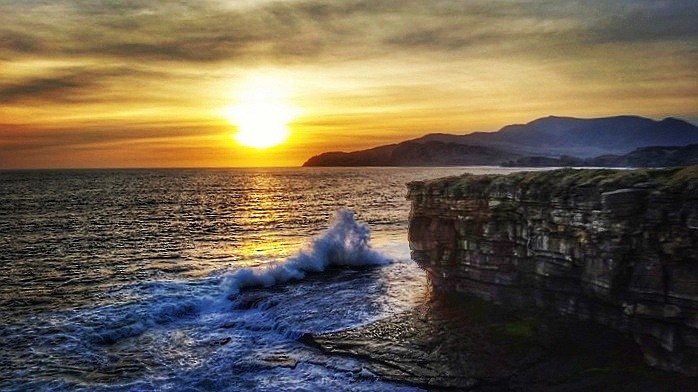
Getting Around
Rural Donegal requires private transport to allow you to travel around the county. There are regular bus services to Letterkenny and Donegal Town at the north and south main road entry points into the county but once you venture into the interior the public transport system almost disappears. Once in Donegal there are few main roads, and you shouldn't expect to get anywhere fast, but you're not in a rush so that's fine.
Accommodation Advertise here
No Premier Listings found in this area
There are a few independent hostels dotted around the county, but their scarcity is sometimes reflected in the price. The cheapest hostel for climbers is at Malin Beg near the cliffs of the same name. It's €15-19 per person per night. There are many campsites and touring parks in the county and their details are available from Google or local Tourist Information offices. If you're in a van, then there are many options. As with Scotland, parking up overnight never seems to be an issue as long as you're not in someone's driveway or farm access track. AirBnB is also an option if you are prepared to put in the leg work to find decent options for the climbing areas, most of which are on the coast.
Guidebook
This is an interesting question, there are two options here, one is free, the other is not and their contents are broadly the same as both are written by the same person. Local legend and good time guy Iain Miller has a website which contains all the pdfs for every area in the county, from the big cliffs of Sail Rock to the mad islands off the coast via the long mountain routes inland. He includes some of the millions of slightly unhinged sea stacks off the coast, which he has spent years documenting, climbing and escaping from.
The paper version of the guide was published in 2014 and is available through Mountaineering Ireland.
Food and Supplies
Only the big towns like Donegal and Dungloe are blessed with Aldis and Lidl super markets. Smaller towns like Ardara and Gweedore might have a Cope, which is the Irish version of the Co-op.
Outdoor Shops Advertise here
No Premier Listings found in this area
There are no local climbing gear shops so bring everything, including a spare belay device in case you drop yours in the sea. The closest two places to buy climbing gear is Sligo Town, an hour south of Donegal Town or Belfast, two hours east.
Water and Showers
This is worth a special mention, as it's oddly difficult to get either of these if you're not staying in some sort of establishment. Travelling round Scotland or Wales is made easier by the availability of both, whether in friendly campsites, community centres or leisure centres. In Donegal, it was very difficult to get showers. Campsites, touring parks and hostels refused to allow non residents to use a shower, even if money was offered. Community centres were very unwelcoming, and there was only one leisure centre (in reality a spa open to the public) in the whole of the county that we could find, at the back of the An Chúirt Court Hotel, Gweedore. Entry was €10, but the nice people on reception allowed me to use the showers for free. That was unusually welcoming and generous for Donegal so good for them. Whilst there you could use their sauna, steam room and swimming pools so that's an option for a rest day. As for water, some petrol stations have taps that you can fill up from, and sometimes, you might see a public tap by the side of the road, but you have to tune in to spot these; they're old fashioned, green metal things.
Wet weather/rest day options
There are a lot of very good beaches in Donegal, so the options for cultivating your tan, or having a nice swim are fairly good. Specific beaches like the glorious Silver Strand at Malin Beg are renowned for their beauty, but there are many others. Cruit Island has some lovely, shallow bays with sandy bottoms, which is what you'll have if you're lucky. Other than that, strolling along cliff tops or taking day trips to many of the offshore islands are good ways to spend a day. The Peruvian volcano-like Errigal Mountain is an eye catching peak that only takes a couple of hours to climb and has great views. Sea kayaking along the Donegal coast and paddling out to the many uninhabited islands found off shore provides great sport. Carefully planning with weather and sea conditions allows visits to an almost endless supply of spectacular sea caves, arches and tunnels on each island. Beyond this traditional Irish craic involves Guinness and live trad music on street corners or in the back rooms of many of the bars around the county.
Unlike Wales, Scotland and England, footpaths and bridleways are notable by their almost complete absence in Donegal. There are a few official footpaths (e.g. up Errigal Mountain) but by and large if you want to go for a walk or a mountain bike ride you'll be on the roads. Keep Out and Private signs are everywhere. This 19th century approach to access is probably best viewed as a reminder of what we could have in the rest of the British Isles, had battles not been fought in the early part of the 20th Century.
Nesting restrictions
This can sometimes be a complex business but in Donegal it's not. None of the developed crags are on bird-ridden cliffs so this is one thing that you can comfortably and happily remove from your calculations. Obviously there are nesting birds and sometimes they stray onto climbing cliffs, but the bottom line is that it isn't an issue. However, that being said, if you end up on a route and find yourself being attacked by gannets, then maybe go elsewhere.
Grades, cliffs, tides and all that
Donegal is a paradise for climbers operating up to VS. There are more routes at that grade and below than almost any other area I can think of. There's also plenty above that grade, and for those of you who like terrifying adventures on sea stacks, Iain Miller's online guides and videos will get you all sweaty with a heady mixture of excitement and fear and a lifetime or two of adventure.
With many cliffs being tidal, you have to plan that into your day. Sometimes, the tidal range is limited and neither high nor low tide seems much different, but then a swell and onshore wind can quickly change the situation to something more serious. As with all sea cliffs, use your common sense and take note of the conditions. There's always tomorrow. In May & June, the days often started dull and slightly damp, but then rapidly improved to become glorious evenings.
The west coast gets lots of weather and that sometimes involves rain. The judicial use of weather forecast and phone calls to local shops/pubs can easily get you a sunny and/or dry crag for the day. Cruit Island, for example, seems to be Donegal's equivalent of Anglesey, with its sunny micro-climate, palm trees and golf course.
Conclusion
Donegal is a grand place to climb. The coastal scenery is varied and intriguing and there are so many routes you could fill many return visits. The area is a curious mixture of Cornwall, Devon and Gogarth, but without the traffic, the crowds or the parking fees. You could spend an entire trip on just one of the larger islands, and not even register that there is just as good climbing elsewhere, not too far away. The opportunities for first ascents at all grades is possibly better here than anywhere else in the British Isles.











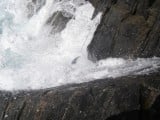
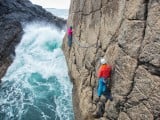
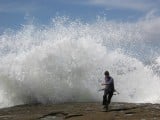



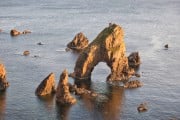
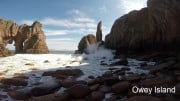
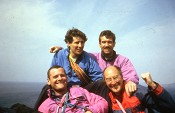

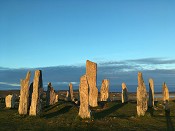
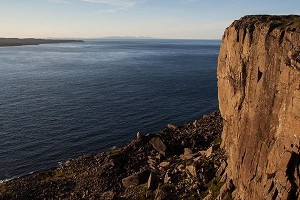
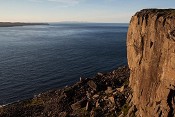



Comments
Looks great but seems to have a map of Dublin in the article??
That's a hell of a lot of crags around Dublin - can that be real?
Fantastic article - one of the reasons that UKC is on this planet!
Great article!
However as a climber and regular visitor to the area I can add a couple of bits... Travel wise you can fly direct into Derry Airport, which also has car rental facilities and, being just over the border, is a short drive to Donegal. There's also an excellent indoor climbing wall in Derry, which is worth knowing in case it rains. Which it will.
There's also a yearly Climbfest held by a local climbing club every year over the Mayday bank holiday. We went a couple of years ago, and it's a great way to meet other climbers in the area and discover new routes and crags.
Good point. The climbfest thing is/has been based on Cruit Island and Malinbeg which are ideal for loads of friendly cragging. Check out the website of the Colmcille Club for details:- http://colmcille-climbers.com/2018/03/climbfest-2018-info/